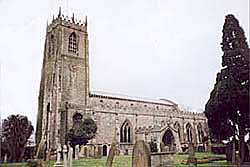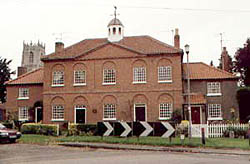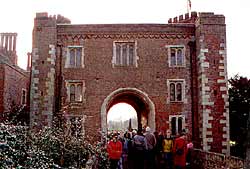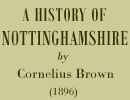< Previous | Contents | Next >
Blyth and Hodsock Priory

The Priory Church of St Mary and St Martin, Blyth. The impressive nave dates from the late 11th century; the tower was erected in the 15th century (A. Nicholson, 1999).
The tower of Blyth Church may be seen rising prominently in the landscape as the visitor travels from Ranskill Station, from which Blyth is distant about two miles. The meandering river Ryton threads its way through the village, which, indeed, has the appearance of a small market town, with broad streets and open spaces. No satisfactory solution is given of the derivation of the name of Blyth, and the early origin of the place is enshrouded in antiquity; but it was part of the vast possessions with which the Conqueror loaded his favourite follower, Roger de Builli, who established a religious house here in 1088, inhabited by the monks of the Benedictine Order, and granted to it the church and township, as well as the customs appertaining to the manor. The Norman noble also conferred the privilege of holding a market, and further endowed it with property in various Nottingham-shire villages.
Tradition has it that Roger de Builli built a castle at Blyth, but there are no traces of any such stronghold left in the village, and if there ever was a fortified place here, it was probably not of great importance, as the warrior’s chief residence was not more than four or five miles away, at Tickhill. The alien character of the Normans was never better illustrated than in the injunction laid upon the monks to pay 40s. per annum to the Church of the Holy Trinity at Rouen, and in the Abbot of this church was also vested the appointment of Prior of Blyth. It soon, however, shook itself free from foreign domination, as may be gathered from documents quoted in Dugdale’s ‘Monasticon,’ and Precentor Venables, in a pamphlet on the subject, shows how the monks became independent of the Norman Abbot, and held their endowments at their own pleasure.

Late 18th century former Rectory (A. Nicholson, 2000).
Soon after the introduction of the monks the sound of chisel and mallet was heard in the erection of the splendid parish church. This work was completed about the middle of the fourteenth century, when the tower reared its lofty head to be a landmark in the distance. The monastic buildings were on the north side, and the cloister adjoined the church, the rest of the premises occupying the spot where Blyth Hall now stands. Nothing remains of the portion once tenanted by the monks, and the conventual choir, extending 60 feet eastwards beyond the present church, has long been swept away.
The Abbot of Rouen seems to have exercised the right to appoint a Prior down to Henry IV.’s time, but the dignity was not always conferred upon a foreigner, as in 1273 William Burdon, of Maplebeck, held the office. The hospitality of the monastery was often put to the test by royal and distinguished personages, for Henry I. and Henry II. both visited it; and one of the witnesses to a charter, granted by the latter monarch on his sojourn here, confirming the monks in their possessions, was Thomas A Becket, Archbishop of Canterbury. Another witness was Ralph de Broc, in whose castle at Saltwood the murder of the prelate was planned.
Blyth was one of the five places licensed by King Richard I. for the holding of tournaments. The Popes had denounced these exhibitions of skill in arms, but Richard was not the one to bend to the mandate of the Church in this particular, so he issued his royal license to five localities where tourneys might be permitted. A level tract of land between Blyth and Styrrup was the locality where the feats of horsemanship took place, in which the flower of English chivalry engaged sometimes under the personal patronage of royalty itself. We can well imagine the animated scenes that must have occurred at these warlike gatherings, and the busy aspect on such occasions of the Angel Inn, just opposite the monastery—a hostelry existing from time immemorial. Many allusions are made in the Close Rolls to the Blyth meetings, which continued till the end of the sixteenth century, when the popular taste began to change and tournaments became but a reminiscence of the past.
At the time of the dissolution of the monasteries Blyth was granted, in 1543, to Richard Andrews, of Gloucester, and William Ramsden, of Longley, Yorks. They appear to have been stock-jobbers in monasteries, and within a fortnight disposed of the property, which passed through the Stansfields and Stanhopes to Robert Saunderson in the time of James I., one of whose sons became the famous Bishop Saunderson of Lincoln. In 1635 William Saunderson sold the estate to John Mellish, and in the north aisle of the church stands a fine stone monument to Edward Mellish, who died in 1703. This gentleman was a merchant in Portugal, and it was he who built the mansion which stands on the north side of the church. A beautiful memorial brass is erected on the south wall to Sir George Mellish, Lord Justice of Appeal, and others to Lieutenant-Colonel William Leigh Mellish and Colonel Henry Francis Mellish. The Blyth estate was sold in 1806 to Mr. Joshua Walker, of Clifton, near Rotherham, and the church was restored in 1885 at a cost of £2,500, the work being undertaken chiefly through the praiseworthy energies of the Rev. Canon Gray.

The brick gatehouse at Hodsock Priory dates from the early 16th century (A. Nicholson, 2001).
The seat of the Mellish family is now at Hodsock Priory, two miles from Blyth. On the site of the house was once the mansion of the Cressys, who were warriors in the time of the Crusades. They founded a leper hospital at Blyth Spital, and were succeeded in the ownership of the estate by the Cliftons in the fourteenth century. It was sold by Sir Gervase Clifton, in 1765, to William and Charles Mellish, Esqs., in whose honourable family it remains to-day.
